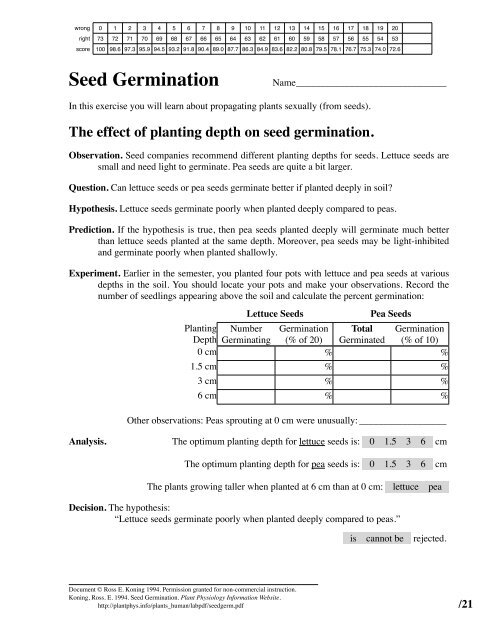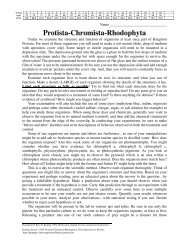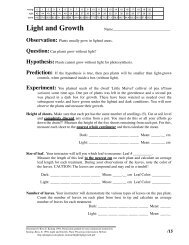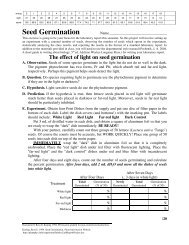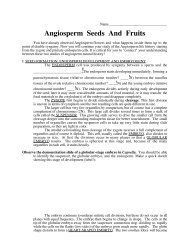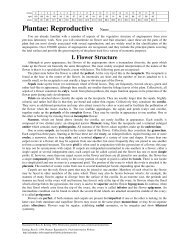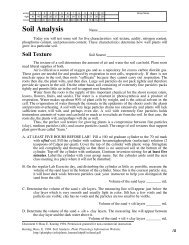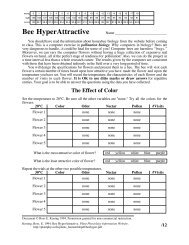Seed Germination - Home Page for Ross Koning
Seed Germination - Home Page for Ross Koning
Seed Germination - Home Page for Ross Koning
Create successful ePaper yourself
Turn your PDF publications into a flip-book with our unique Google optimized e-Paper software.
wrong 0 1 2 3 4 5 6 7 8 9 10 11 12 13 14 15 16 17 18 19 20<br />
right 73 72 71 70 69 68 67 66 65 64 63 62 61 60 59 58 57 56 55 54 53<br />
score 100 98.6 97.3 95.9 94.5 93.2 91.8 90.4 89.0 87.7 86.3 84.9 83.6 82.2 80.8 79.5 78.1 76.7 75.3 74.0 72.6<br />
<strong>Seed</strong> <strong>Germination</strong><br />
Name _______________________________<br />
In this exercise you will learn about propagating plants sexually (from seeds).<br />
The effect of planting depth on seed germination.<br />
Observation. <strong>Seed</strong> companies recommend different planting depths <strong>for</strong> seeds. Lettuce seeds are<br />
small and need light to germinate. Pea seeds are quite a bit larger.<br />
Question. Can lettuce seeds or pea seeds germinate better if planted deeply in soil?<br />
Hypothesis. Lettuce seeds germinate poorly when planted deeply compared to peas.<br />
Prediction. If the hypothesis is true, then pea seeds planted deeply will germinate much better<br />
than lettuce seeds planted at the same depth. Moreover, pea seeds may be light-inhibited<br />
and germinate poorly when planted shallowly.<br />
Experiment. Earlier in the semester, you planted four pots with lettuce and pea seeds at various<br />
depths in the soil. You should locate your pots and make your observations. Record the<br />
number of seedlings appearing above the soil and calculate the percent germination:<br />
Lettuce <strong>Seed</strong>s<br />
Pea <strong>Seed</strong>s<br />
Planting Number <strong>Germination</strong> Total <strong>Germination</strong><br />
Depth Germinating (% of 20) Germinated (% of 10)<br />
0 cm % %<br />
1.5 cm % %<br />
3 cm % %<br />
6 cm % %<br />
Other observations: Peas sprouting at 0 cm were unusually: __________________<br />
Analysis. The optimum planting depth <strong>for</strong> lettuce seeds is: 0 1.5 3 6 . cm<br />
The optimum planting depth <strong>for</strong> pea seeds is: 0 1.5 3<br />
6 . cm<br />
The plants growing taller when planted at 6 cm than at 0 cm: lettuce pea .<br />
Decision. The hypothesis:<br />
“Lettuce seeds germinate poorly when planted deeply compared to peas.”<br />
is cannot be<br />
rejected.<br />
Document © <strong>Ross</strong> E. <strong>Koning</strong> 1994. Permission granted <strong>for</strong> non-commercial instruction.<br />
<strong>Koning</strong>, <strong>Ross</strong>. E. 1994. <strong>Seed</strong> <strong>Germination</strong>. Plant Physiology In<strong>for</strong>mation Website.<br />
http://plantphys.info/plants_human/labpdf/seedgerm.pdf /21
<strong>Page</strong> 2<br />
The effect of fruits on seed germination.<br />
Observation. <strong>Seed</strong>s do not germinate inside their fruits even though it is moist and warm inside<br />
the fruit.<br />
Question. Do the juices surrounding seeds inhibit their germination?<br />
Hypothesis. The juices surrounding seeds inhibit their germination.<br />
Prediction. If the hypothesis is true, then seeds placed in fruit juice will not germinate as well as<br />
seeds placed in water.<br />
Experiment. Obtain three Petri Dishes from the supply and put one disc of filter paper in the<br />
bottom of each dish. The bottom is the smaller of the two dishes and fits inside the cover.<br />
Label the dish covers (and bottoms!) with the marking pen. The labels should be:<br />
Water in light Tomato Juice in light Abscisic Acid in light<br />
Put 5 mL of distilled water in the first dish, 5 mL of tomato juice in the second dish,<br />
and 5 mL of 1 mM Abscisic Acid in the third dish.<br />
With your partner, carefully count out three groups of 50 ‘Tango’ lettuce seeds. Of<br />
course the counts must be accurate, but WORK QUICKLY! Place one group of 50 seeds<br />
into each dish on top of the moist paper.<br />
Place the three dishes under the white fluorescent lights to allow the seeds to<br />
germinate.<br />
After the initial and followup treatments, count out the number of seeds germinating<br />
and express as percent germination.<br />
Initial ____ Days<br />
Followup ____ Days<br />
Treatment Total <strong>Germination</strong> Newly Total <strong>Germination</strong><br />
Germinated (% of 50) Germinated Germinated (% of 50)<br />
Water + light % %<br />
Tomato Juice + light % %<br />
Abscisic Acid + light % %<br />
Other observations: ________________________________________________________<br />
__________________________________________________________________<br />
Analysis. More seeds germinated in: water tomato juice abscisic acid .<br />
Is there good evidence that abscisic acid is the active hormone in tomato juice? yes no .<br />
Decision. The hypothesis: “The juices surrounding seeds inhibit their germination”<br />
is cannot be<br />
rejected.<br />
/22
<strong>Page</strong> 3<br />
The effect of light on seed germination.<br />
Observation. <strong>Seed</strong>s of some species germinate in the light but do not do so well in the dark. The<br />
pigment phytochrome has two <strong>for</strong>ms, Pr and Pfr, which absorb red and far-red light,<br />
respectively. Perhaps this pigment helps seeds detect the light.<br />
Question. Do species requiring light to germinate use the phytochrome pigment to determine if<br />
they are in the light or darkness?<br />
Hypothesis. Light-sensitive seeds do use the phytochrome pigment.<br />
Prediction. If the hypothesis is true, then lettuce seeds placed in red light will germinate much<br />
better than seeds placed in darkness or far-red light. Moreover, seeds in far-red light<br />
should be particularly inhibited.<br />
Experiment. Obtain three Petri Dishes from the supply and put one disc of filter paper in the<br />
bottom of each dish. Label the dish covers (and bottoms!) with the marking pen. The<br />
labels should be:<br />
Water in red light Water in far-red light Water in dark<br />
Put 5 mL of distilled water in each dish, and obtain a square of aluminum foil so<br />
that you are ready to wrap the “dark” dish immediately. BE READY!<br />
With your partner, carefully count out three groups of 50 lettuce seeds. Of course<br />
the counts must be accurate, but WORK QUICKLY! Place one group of 50 seeds into<br />
each dish on top of the moist paper.<br />
IMMEDIATELY wrap the "dark" dish in aluminum foil so that it is completely<br />
enshrouded. Place the "red light" dish under red plexiglass with fluorescent lighting. Place<br />
the "far-red light" and the “dark” dishes under red and blue plexiglass with incandescent<br />
lighting.<br />
After the initial and followup treatments, count out the number of seeds<br />
germinating and express as percent germination. After the initial count, add 2.5 mL of<br />
distilled water, and move all the seeds into white light <strong>for</strong> followup.<br />
Followup ____ Days<br />
Initial ____ Days<br />
(in white light)<br />
Total <strong>Germination</strong> Newly Total <strong>Germination</strong><br />
Initial Treatment Germinated (% of 50) Germinated Germinated (% of 50)<br />
Water in red light % %<br />
Water in far-red light % %<br />
Water in darkness % %<br />
Analysis. In the initial treatment, the most seeds germinated in red far-red darkness .<br />
In the initial treatment, the fewest seeds germinated in red far-red darkness .<br />
The germination-simulating <strong>for</strong>m of phytochrome is: Pr Pfr .<br />
Decision. The hypothesis: “Light-sensitive seeds do use the phytochrome pigment”<br />
is cannot be<br />
rejected.<br />
/21
Questions to Answer at <strong>Home</strong><br />
<strong>Page</strong> 4<br />
Defend the statement: "Lettuce seeds need light to germinate" using the data you obtained in<br />
laboratory.<br />
Lettuce seeds do need light to germinate, because germination of seeds was more less<br />
in the dark than in white light. Moreover, after the initial treatment of darkness, the<br />
ungerminated seeds were exposed to white light and more no more germinated.<br />
Condemn the statement: "Lettuce seeds need light to germinate" using the data you obtained in<br />
laboratory.<br />
Lettuce seeds do not need light to germinate, because germination of seeds in the initial<br />
darkness was more than 0 5% in white light .<br />
Explain how you can tell whether far-red light had any effect.<br />
<strong>Seed</strong> germination after the intial treatment in far-red light was more less<br />
than seed germination in the control seeds which were in white red darkness .<br />
The failure of a seed to sprout could be due to the fact that its germination is indeed inhibited.<br />
But there is also a second possibility: perhaps the treatment does not inhibit seed<br />
germination directly, but simply kills the embryo. Such a situation would certainly not<br />
produce a germinating seed. In this exercise you exposed the seeds treated with far-red<br />
light to white light <strong>for</strong> an additional time and observed germination again. Present<br />
arguments <strong>for</strong> both possibilities!<br />
Initial far-red light inhibits germination.<br />
My evidence is that germination after the white light followup exposure was...<br />
more less than _____________________________________________<br />
Initial far-red light kills the embryo.<br />
My evidence is that germination after the white light followup exposure was...<br />
more less<br />
than ____________________________________________<br />
/9


